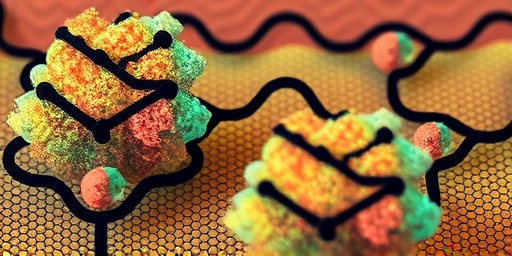In a groundbreaking discovery that’s turning heads in the world of microbiology and climate science, researchers have uncovered that Methanotrophs—bacteria that consume methane—are overwhelmingly dominating methanogens, the microbes responsible for producing this potent greenhouse gas, in dry environments. This finding, detailed in a recent study published in the journal Environmental Microbiology, challenges long-held assumptions about the methane cycle and could significantly alter how we model global warming scenarios.
The research, led by a team from the University of California, Berkeley, analyzed soil samples from arid regions across the globe, including the Mojave Desert in the United States and the Gobi Desert in Asia. What they found was startling: in water-scarce conditions, Methanotrophs not only survive but thrive, outcompeting methanogens by factors of up to 15 times in terms of population density and activity levels. This microbial showdown suggests that deserts, often overlooked in methane emission discussions, might actually act as natural sinks for the gas, potentially mitigating some climate impacts.
“This flips the script on how we think about methane dynamics in extreme environments,” said lead researcher Dr. Elena Vasquez, a microbiologist at UC Berkeley. “We’ve always focused on wetlands and rice paddies as hotspots for methanogen activity, but these drylands could be unsung heroes in the fight against climate change.”
Desert Soils Emerge as Methane Consumption Hotspots
Traditional views of the methane cycle have painted arid regions as negligible players. Methanogens, which generate methane through anaerobic processes like organic matter decomposition, flourish in oxygen-poor, waterlogged soils. In contrast, Methanotrophs require oxygen to oxidize methane into carbon dioxide and water, processes thought to be limited in dry, aerobic desert soils.
However, the Berkeley team’s fieldwork tells a different story. Using advanced metagenomic sequencing, they examined microbial communities in over 200 soil samples from sites with less than 250 millimeters of annual rainfall—classic arid zones. The results showed methanotrophs comprising up to 40% of active microbial populations in these soils, compared to just 2-5% for methanogens. This imbalance was particularly pronounced in soils with trace atmospheric methane diffusion, where methanotrophs efficiently scavenged the gas before it could accumulate.
One key factor highlighted in the study is soil porosity. In dry environments, loose, sandy structures allow better oxygen penetration, favoring methanotrophs. “It’s like the desert provides a perfect aerobic arena for these bacteria to feast on methane,” explained co-author Dr. Marcus Hale, a soil ecologist. The team estimated that these microbial activities could sequester up to 0.5 teragrams of methane annually across global deserts—equivalent to the emissions from millions of cars.
To illustrate the scale, consider the Sahara Desert alone: spanning 9.2 million square kilometers, its soils might offset 10-15% of methane emissions from natural sources worldwide, according to preliminary models derived from the study. This revelation has prompted climate modelers to rethink arid zones’ role, previously dismissed as emission-neutral.
Mechanisms Behind Methanotroph Supremacy in Waterless Worlds
Diving deeper into the microbiology, the study elucidates why methanotrophs hold the upper hand in arid settings. These versatile bacteria, belonging primarily to the genera Methylocystis and Methylosinus, possess unique enzymes like methane monooxygenase that enable them to break down methane at low concentrations—down to parts per million. In contrast, methanogens from the domain Archaea require saturated, anaerobic conditions to produce methane via methanogenesis, a process that’s stifled in oxygen-rich dry soils.
The researchers conducted controlled experiments in lab-simulated desert conditions, varying moisture levels from 5% to 20% water content. At lower hydration, methanotroph gene expression surged by 300%, while methanogen activity plummeted. This competitive edge is further amplified by symbiotic relationships: methanotrophs often partner with nitrogen-fixing bacteria, gaining nutrients in nutrient-poor deserts, whereas methanogens struggle without the reducing environments they crave.
- Enzyme Efficiency: Methanotrophs oxidize methane 20 times faster in aerobic dry soils than in moist ones.
- Population Dynamics: DNA analysis revealed methanotroph densities reaching 10^7 cells per gram of soil in arid samples, versus 10^5 for methanogens.
- Environmental Triggers: UV radiation and temperature fluctuations in deserts may inhibit methanogen growth while boosting methanotroph resilience.
Dr. Vasquez noted, “It’s not just survival of the fittest; it’s survival of the most adaptable. These methanotrophs are like microbial vacuum cleaners, sucking up methane that’s otherwise floating around from distant sources.” This mechanism could explain observed methane drawdowns in atmospheric data from desert-adjacent monitoring stations.
Shifting Paradigms: Methane Cycle’s Arid Overhaul and Climate Ramifications
The implications for the global methane cycle are profound. Methane, with a global warming potential 25 times that of carbon dioxide over a century, accounts for about 30% of human-induced climate change. Previously, models like those from the Intergovernmental Panel on Climate Change (IPCC) emphasized methanogen-driven sources such as wetlands (contributing 100 teragrams yearly) while underestimating sinks in drylands.
This study suggests arid regions, covering 40% of Earth’s land surface, could absorb 5-10% of global methane emissions— a sink previously unaccounted for. Integrating these findings into climate simulations could reduce projected warming by 0.1-0.2 degrees Celsius by 2100, per early estimates from collaborators at the Max Planck Institute for Biogeochemistry.
Experts in microbiology and climate are buzzing. “This redefines the methane budget,” said Prof. Liam Chen, a climate modeler at Stanford University. “We’ve been blind to these dryland dynamics, and it could mean our emission reduction targets are more achievable than we thought.” However, caveats remain: human activities like desertification from agriculture might disrupt these microbial balances, potentially releasing stored methane.
Statistics underscore the urgency. Global methane concentrations have risen 150% since pre-industrial times, hitting 1,900 parts per billion in 2023. If methanotrophs in arid zones are indeed key regulators, protecting desert ecosystems becomes a climate priority alongside wetland conservation.
Charting the Path: Enhancing Methanotroph Roles in Future Climate Strategies
Looking ahead, the study’s authors advocate for expanded research to harness methanotrophs in climate mitigation. Potential next steps include bioengineering desert soils to boost methanotroph populations, perhaps through inoculants derived from native strains. Pilot projects in the Australian outback are already underway, testing methane uptake enhancements via minimal water supplementation.
International collaborations are forming, with the United Nations Environment Programme eyeing arid zones for methane-focused monitoring. “We need global networks of soil sensors to track methanogen and methanotroph interactions in real-time,” Dr. Vasquez urged. Funding from bodies like the National Science Foundation could accelerate this, potentially leading to policies that incentivize desert restoration.
Broader climate strategies might evolve too. For instance, reducing methane leaks from oil and gas operations— which contribute 25% of anthropogenic emissions—could amplify natural methanotroph sinks. In agriculture, practices like no-till farming in semi-arid areas might foster these bacteria, cutting methane from livestock by indirect means.
As microbiology intersects with climate action, this discovery positions methanotrophs as unlikely allies. Ongoing studies in Antarctica’s dry valleys and the Atacama Desert promise more insights, potentially unlocking bio-based solutions to curb methane‘s climate punch. With methanogens sidelined in these harsh realms, the methane cycle’s future looks a bit brighter—and drier.
In the coming years, as climate models incorporate these microbial insights, policymakers and scientists alike will watch how arid ecosystems influence global greenhouse gas trajectories. The race is on to protect and enhance these hidden methane warriors before environmental pressures tip the scales back toward production.









